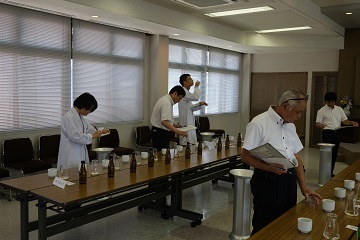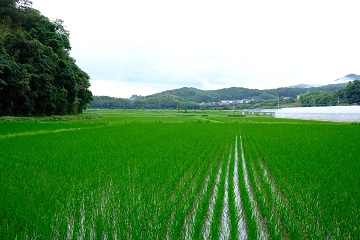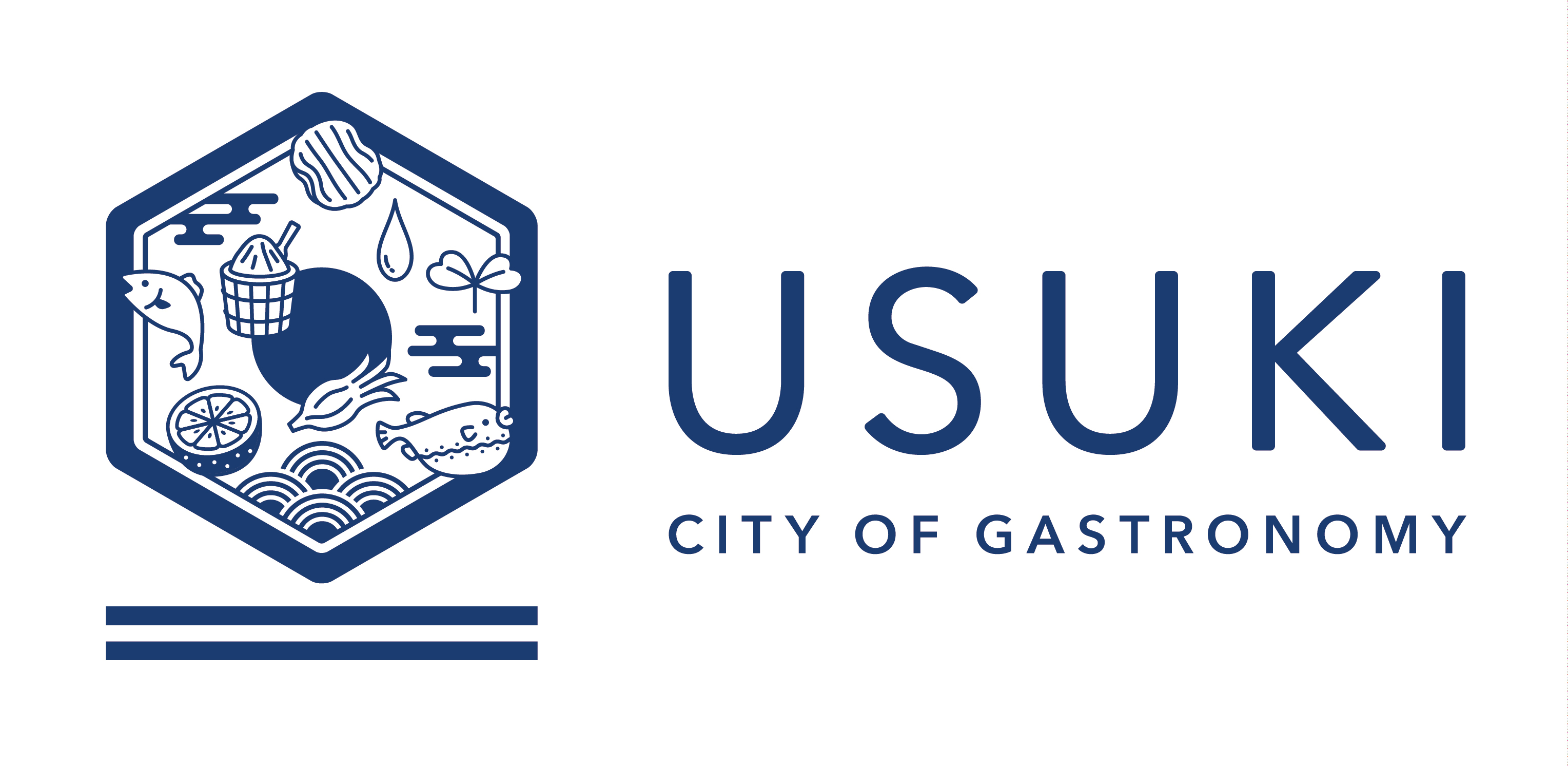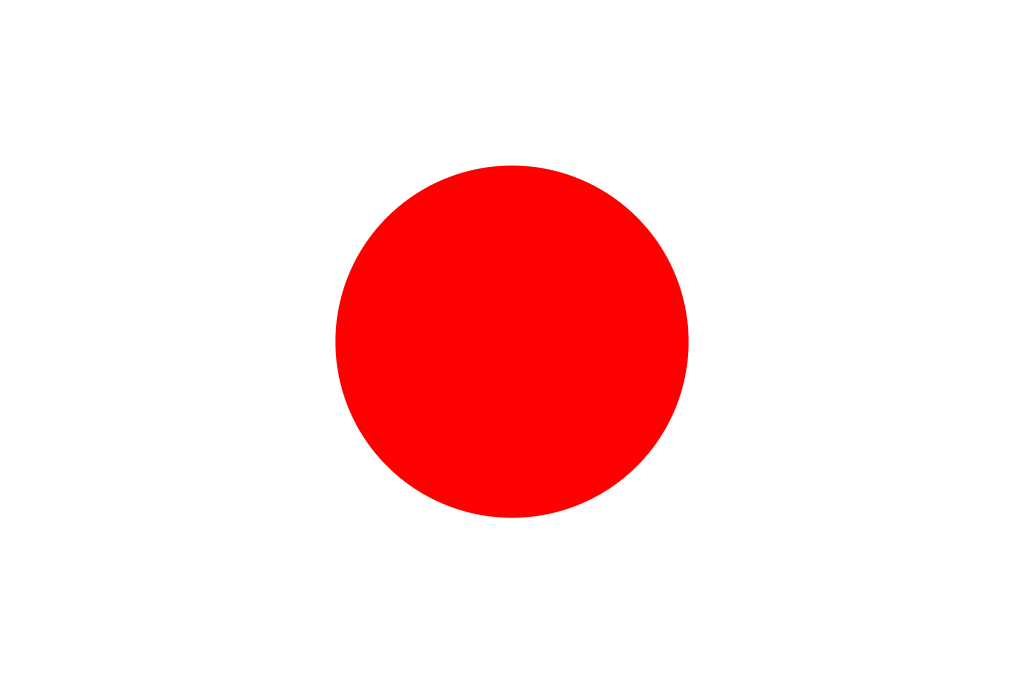Bottling - Hiyaoroshi (August 31, 2020)
The sake brewed from winter to spring, heated and stored at sake breweries, is maturing mildly. By the time the temperature of the sake and the autumn air reach equilibrium, the sake’s initial roughness will have disappeared completely.
It is at this time that sake is considered to be at its most drinkable.
This season’s bottled sake (mainly junmai) is called hiyaoroshi.
Our junmai - Ichinoide Hayaoroshi received a high evaluation for its “clean” taste at this summer’s Nomi-kiri, and we are looking forward to it getting even better with age. The Vol. is a little higher at 17%, so please enjoy! Scheduled for release on September 7 (Monday).
Initial Sampling - Nomi-kiri (August 4, 2020)
 |
 |
Manager, Ms. Iwata, and Technical Officer Komatsu of the Kumamoto Regional Taxation Bureau’s appraisal office and the teachers from the Oita Industrial Research Institute offered guidance regarding storage and shipping management at the Oita Prefectural Sake Brewery Association’s office.
This year, in order to limit the spread of coronavirus, the meeting was held over three days and the attendees from the Oita breweries were divided up. Thanks to the relatively small groups, we had more time to absorb the useful guidance and advice.
We will strive to continue supplying high-quality sake to our customers.
Nomi-kiri (initial sample) is a quality check that is performed to check the progress of ageing and to detect irregularities such as abnormal colouring caused by heating or iron contamination.
A Field of Wakamizu Rice - Rice that is Fantastic for Sake Brewing (July 14, 2020)

This is the Wakamizu rice field in Ieno, Usuki City. Wakamizu is a fantastic rice and great for sake brewing. We use it for our tokubetsu junmai - Ichinoide and tokubetsu junmai muroka namagenshu - USUKI.
Our president’s old classmate, Mr. Minato, cultivates Wakamizu with all his energy and heart. Whilst weeding he updated me on the progress of the crop, “It is growing well”, he said.
In this quiet rural landscape, it’s hard to imagine that elsewhere the coronavirus is causing havoc to society.
Heating Sake (Hiire) for our Tokubetsu Junmai (April 6, 2020)
The main purpose of heating the sake (hiire) is to sterilize and deactivate the remaining enzymes such as amylase and protease.
By storing and allowing the sake to mature following the heating process (hiire), the roughness and odour (shinshubana or kojibana) associated with the hiire-stage will disappear. In addition, the maturity can be adjusted by controlling the temperature, thus controlling the flavour.
Normally, heating (hiire)is completed in 2 to 3 minutes at 62 to 63℃. Heating is less effective as the number of hiochi bacteria increases, and sterilization is especially difficult when the bacteria are grouped together. So, it’s important to be extra cautious during this process.
In addition, to avoid over-maturing, it is necessary to cool the liquor promptly after heating (hiire).
Our tokubetsu junmaishu is heated using a serpentine (coiled) tube. The tube is placed in a hot water tank at a temperature of 70℃. The sake enters the tube at its stored temperature, around 15℃, and passes through it at a constant speed. It takes the sake a few minutes to make its way to the end of the tube, and when it finally emerges, its temperature has risen to 68℃. On this occasion, the sake went from No.585 tank to No.592 tank.
The First Stage - Hatsu-zoe (Soejikomi) (March 16, 2020)
The purpose of the first stage (hatsu-zoe) of shikomi, the three stages of mashing, is to further grow the yeast that has so far been solely cultivated in the shubo and is currently in an inactive state following the drying period (karashi).
Since the quantity of yeast starter (shubo) is small in comparison to the size of the tank, special care must be taken to maintain the product’s temperature.
1, Koji and water mixture - Mizu-koji.
1 to 3 hours prior to adding the steamed rice, the yeasts starter (shubo), koji and water are placed in the brewing container. The process is called soe no mizu-koji.
The standard temperature of mizu-koji is 7 to 9℃, which is 3 to 5℃ lower than the planned preparation temperature (please see the first part of the video).
2, Preparation - Shikomi.
First, we take the temperature of the mizu-koji and then calculate the ideal temperature for the steamed rice. The steamed rice is then cooled to the planned temperature. We then add the steamed rice to the container with the mizu-koji which we stir with a kind of paddle called a kaiire.
Care must be taken to stir the mixture gently with the kaiire. The steamed rice will be crushed if it is stirred too vigorously.
Sake Lees Ratio - Kasuhanashi Tokubetsu Junmai Sake (March 14, 2020)
The process of removing sake lees (kasu) from the bags and filter plates after pressing (joso) is called kasuhanashi. Once kasuhanashi is complete, we weigh the remaining lees (kasu) and compare this to the weight of the original white rice used. This ratio is called kasubuai. Typically, the ratio is normally about 20-30%, and it is generally accepted that the higher the rate of lees, the better the quality of sake.
The characteristics of the lees (kasu) are a good representation of the fermentation and the state of the raw materials used and can be used as a gauge for the management of the next mash (moromi).
The average percentage of sake lees (kasu) at Kuge Honten is about 30% or more, and its properties are beautiful and smooth, and it has a clean liquor quality (although, not economical).
While the scent of fresh sake lees drifts in the air, section chief, Mr. Shoji Kuge, and Mr. Takeguchi from the product section, were carefully dividing and removing the sake lees (kasu) piece by piece.
Heating (Hiire) our Exhibition Sake (March 4, 2020)
The main purpose of heating the sake (hiire) is to sterilize and deactivate the remaining enzymes such as amylase and protease.
By storing and allowing the sake to mature following the heating process (hiire), the roughness and odour (shinshubana or kojibana) associated with the hiire-stage will disappear. In addition, the maturity can be adjusted by controlling the temperature, thus controlling the flavour.
Normally, heating (hiire)is completed in 2 to 3 minutes at 62 to 63℃. Heating is less effective as the number of hiochi bacteria increases, and sterilization is especially difficult when the bacteria are grouped together. So, it’s important to be extra cautious during this process.
In addition, to avoid over-maturing, it is necessary to cool the liquor promptly after heating (hiire).
At Kuge Honten, for the sake that we exhibit at appraisals, we temporarily transfer it from the bottle (tobin) to a titanium container prior to heating (hiire). This reduces the risk of over-maturing the sake.
Mounding - Mori (March 2, 2020)
8 to 10 hours after kirikaeshi, the temperature of the steamed rice has risen by 1-2℃. At this point, the mycelia that have grown on the steamed rice will be visible to the naked eye. The mycelia (haze) appear white on the steamed rice. At this time, the size of the haze varies from around 3-6mm, so they are barely visible. As the mycelia become visible the temperature gradually increases. At this point, we want to make sure that the steamed rice remains moist, so we begin the mounding (mori) stage.
This stage involves placing koji boxes on linen or synthetic fibre cloths. We then divide quantities of the loose steamed rice into the boxes. The steamed rice is piled up to create a layer around 6-8cms thick. Finally, the boxes are covered with a cotton cloth. At this time, the rice grains have been separated, so they are loose.
Today we processed a large quantity of rice, 120kgs for the soe’s koji and 60kgs for the shubo’s koji (both for ordinary sake).
Where the rice grains had stuck together, we used a koji-kirikaeshi machine to break down the lumps.
Medium-Temperature Fast-Brewed Shubo for Ordinary Sake
Fast brewed shubo is a method in which an appropriate amount of lactic acid is added at the time of mizukoji to suppress the growth of germs. At the same time, a large amount of cultured sake yeast is added and only that yeast is purely cultivated.
The lactic acid added during the fast brewed shubo process suppresses the growth of bacteria, but it does not have the power to suppress the wild sake yeast that may have entered with the koji or on the utensils we use.
Therefore, in the case of fast brewed shubo, a large amount of excellent yeast (with ampoules, etc., this time, we used Kyokai No. 701 yeast) is added as early as possible (at the time of mizukoji).
By doing this, the sheer volume of good yeast overwhelms the wild sake yeast, not giving it room to grow.
“Medium temperature fast brewed shubo” is a modification to the fast brewed shubo method. This variation of the method involves using high temperatures during the preparation stage. This promotes saccharification without lowering the product’s temperature during utase, allowing yeast to grow in a shorter period of time. As this method does not require further heating, it is easier for the yeast to grow.
The basic process for mizukoji is the same as using the ordinary fast brewed shubo method, only it is done at a higher temperature, around 25-30℃, and the temperature is then maintained. The shubo will begin to bubble and foam (fukure) on around the second or third day.
Pressing - Joso | Hanging Bags | 2nd Daiginjo (February 25, 2020)
The second mash (moromi ) of Daiginjo (Kumamoto yeast) was hung for pressing (joso). At this point, many different sake brewing processes are overlapping and as a brewer, this is our busiest time. To cope with the large workload, we have drafted in our product division for support.
After fermentation is complete, the mash (moromi) is pressed, separating the liquid (sake) from the solid part (lees). This process is called pressing (joso - agebune), and in this case, we use a tank or an automatic mash presser.
However, for the sake that we exhibit at appraisals, etc., we use a different pressing (joso) method. It involves hanging the mash in “sake bags” and allowing the sake to drip naturally, under its own weight, rather than using external pressure.
This is sometimes referred to as “Shizukuzake” or “Shizukudori” because the sake drips (shizuku) from canvas bags.
Since this kind of pressing doesn’t require external force to separate the sake from the sake lees, relying solely on the weight of the mash, this natural gentler press results in a delightful aroma and delicate taste.
In addition, the method of collecting the pressed sake in a special vessel called a Tobin is known as “Tobindori” or “Tobinkakoi”.



 日本語
日本語